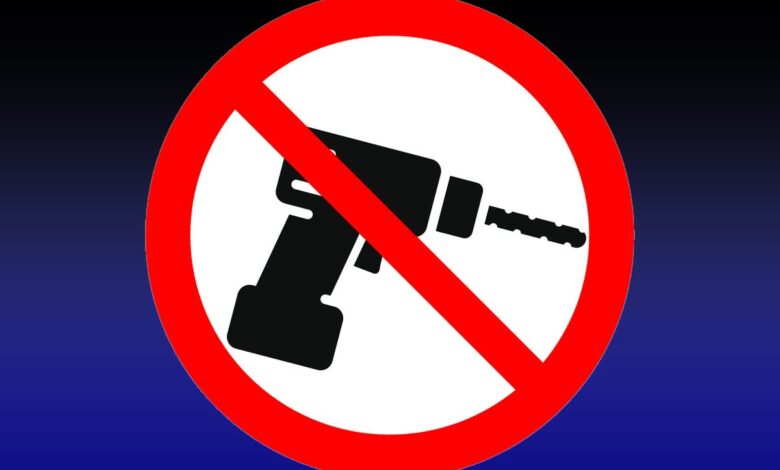Why men don’t buy sex toys – and why it’s OK to blame our tools

We all know the phrase “boys and their toys”. But have you ever stopped to wonder why we never talk about “boys and their sex toys”? Men love gadgets. Men love masturbating. Men also love spending money on random, borderline pointless stuff and talking about it to death. So is there a loud buzz around the male sex toy business? Absolutely not. A middle-aged bike enthusiast might buy seven different bits of lycra to make them cycle faster, but zero bits of silicon to make them cum harder. What’s with that? While it’s not weird for women to recommend cool products like Doxy wands or suction toys to each other, the only masturbation advice I ever had from a man was to sit on my hand until it went numb. We live in a world where capitalism has successfully pervaded literally everything on earth, but still hasn’t managed to get its hands tightly around the male wanking market? None of this makes sense to me.
To be specific, I’m talking about toys aimed mostly at solo use. Masturbation aids. And it’s definitely not true to say that all men don’t buy toys. Men who have sex with men, for example, are generally far more progressive when it comes to normalising sex toy use. Just last week, a friend of mine went into a famous gay lifestyle shop to buy a cockring. He was given advice, able to try a few on, given one-to-one help in the changing room – and it was, y’know, just a shopping experience. No biggie. Gay men are more likely to be marketed cockrings, dildos, ball stretchers, sheaths – and, yes, self-pleasure toys such as strokers and masturbators too. Elsewhere, there’s a growing range of toys for trans and non-binary people, such as pumps for transmasc people, made to work on anatomy under three inches. As a pansexual male, I see attitudes towards sex toys from across the sexual spectrum and am honestly a bit bemused (but not judgemental or sneery) that men who only have sex with women have such a low appetite for trying toys. Much of this, incidentally, is influenced by Liz Truss.
I have a theory I like to call “trickle-down wankonomics”. It begins with the pandemic, which created a gigantic boom in sales. Poppy Scarlett, a sex educator who runs the online sex toy retailer Self & More, saw this incredible growth close up: “We’d see peaks whenever a new lockdown was announced. Orders from the first lockdown alone went up by 508 per cent. Across all areas: anal, vibrators, kink things, partner toys, solo toys – all of it.” Scarlett herself bought her first sex toy from a pub toilet vending machine, aged 16. “I used it so much that the springs popped out of the mechanism.”
Anyway, with so many new sex toys in circulation after the great Covid splurge, I really thought exposure to them would rub off on men. Anecdotally, so many men who sleep with women have told me in the last few years about using her toys during sex – to the point where wands and bullets became an embedded part of their sex life. Yet not one had thought of buying a toy for themselves. Like most trickle-down theories, the logic was flawed. I genuinely find that lack of curiosity, well, curious.
Comparing the sales of toys aimed at men with those aimed at women is widely seen as a bit redundant – the concept being that while most men can “bang one out” in the time it takes to say “Tunnock’s teacakes”, women’s physiology means they often require time and, crucially, toys to orgasm. Scarlett has a sideways take on this, however, based on the fact that “lots of the stats that tell us how long it takes a woman to cum are based on penis-in-vagina sex. Meaning even just our understanding of how long it takes to orgasm comes from a male perspective. It isn’t that it’s necessarily ‘harder’ for a woman to orgasm, just that there’s a knowledge gap around the way people with vulvas need to receive pleasure. It’s not hard,” she says wryly, “if you know what you’re doing.”
There’s a million, very deeply embedded reasons why the majority of men have traditionally said no to self-pleasure accessories. Take the English language, which is a beautiful thing, even when it’s being horrifically ugly. Some of our boldest, go-to swear words – wanker, tosser, jerk-off, jizzrag – all stem from the act of male masturbation. Who would spend a dime on becoming an even bigger wanker? Most men also feel they have the best god-damn tool already – in the form of their hand. Masturbation is the one form of manual labour that people aren’t snooty or stuck-up about still. Furthermore, men have always proved stunningly inventive in the field of wankery. Even the most average of males can display the imagination of Leonardo and the steely focus of an Olympic archer when it comes to furtive self-pleasure. A mate of mine used to have sex with a full bath, his limbs keeping him hovered above it like a frightened cat. I heard a story once about someone who used to draw their own pornography. Someone else used to fill an empty crisp packet with hand lotion, put it between two stacked mattresses, and proceed.
By contrast, female toys are considerably more refined and aspirational than an old crisp packet full of spunk. They’re well designed, boast beautiful colours and come in soft shapes and ergonomic curves. “There’s been a big trend in the industry,” reflects Scarlett, “towards marketing female sex toys and masturbation as a form of self-care. The idea of putting on some sexy underwear or some candles before having a wank. We haven’t really seen that for men yet.” The drift of female sex toys into the safe, Instagram-compliant world of wellness – where cool successful women such as Dakota Johnson, Cara Delevigne and Lily Allen all have a range of toys – has been profound. Even the Argos website has a “Sexual Wellness” section now.
Yet Argos would probably never flog most male toys on their site because most are honestly grotesque. It has always been thus. Probably the most enduring male aid in history – and I’m trying not to wretch over my Dell as I type this – is the sex doll. French sailors in the 16th century used to make dames de voyage out of old clothes. Hitler apparently provided synthetic sex toys for his soldiers fighting in France (blonde and blue-eyed, obviously). Nowadays, a quick Google seems to show that, unless you have deeply paedophilic tendencies, then most sex dolls probably aren’t for you. Moving on, the Fleshlight and Fleshjack are now the best-known toys for people with penises. First developed in 1998 (its original patent back then called it a “discreet sperm collection device”, which is delightful, isn’t it?), a Fleshlight is a hand-operated penetrable sleeve, with an inner lining that you soak in warm water, lube and then use. It’s probably the most socially acceptable male sex toy there has ever been, and yet, thanks to its modelled vaginal or anal opening, it still has that feeling of keeping a disembodied body part in your drawer. Even if you have no lingering religious shame around masturbation, there’s every chance you might feel shame if someone opened your drawer and discovered your anus-on-a-stick.
But this is starting to change. Scarlett points to a small, growing wave of better-designed objects for men that reflect both the less-gendered and less-anatomical trends seen in the majority female market. “Brands such as Tenga make toys that are very designer-led. They come in more abstract geometric shapes, which you could have on display and people wouldn’t necessarily know they were sex toys.” There’s also a rise in tech-focused brands such as The Handy, which is an automated sleeve that can be controlled by someone else remotely, or be synced up to a video to mirror any strokes seen on-screen.
Still, despite these new advances, there’s still the lingering feeling that most male sex toys are – however well designed – physical manifestations of the lingering sense of shame and inadequacy that bygone ages linked with masturbation. I feel like we men need to reset our heads a bit first. We need more open conversations, better sex education (including around masturbation). Straight men especially could do with learning from women and gay/queer men about their sex toy use. Unless we change a bit ourselves, our sex toys will forever be trapped in a vortex of novelty and gimmickry – like a sheath that can double as a remote control for a drone, or a f**kable Blackwall Tunnel for disgruntled drivers who have to cross the Thames twice daily.





